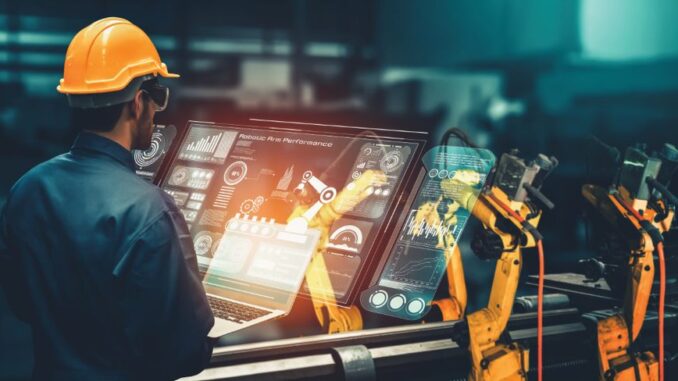
The next Industrial Revolution comes to Ohio
By Terry Troy
When Thomas Malthus predicted back in 1798, that people would eventually starve from a lack of food production, he never foresaw the advances in farming, husbandry and early technology that would quash his ominous prediction.
Fast forward 200 years later and many industrialists, economists and business executives predicted that cheap overseas labor would displace American manufacturing workers, who just couldn’t compete against cheap foreign labor.
While offshoring did occur in the 1980s through the end of the 20th century, those predictions today seem as preposterous as those made over 222 years ago. America will reshore and become more competitive through advanced automation. And Ohio may once again be at the forefront of manufacturing worldwide.
This time around, it’s about the coming of advanced technologies that combine hardware, software, cyber-physical systems, communications and emerging technologies, such as robotics, artificial intelligence, quantum computing, biotechnology, machine learning, fifth generation wireless technologies, 3D printing, autonomous vehicles, the internet of things (IoT) and the Industrial Internet of Things (IIoT).
While that might seem like a daunting list, the purview of advanced manufacturing engineers and computer scientists, the concept is not all that complicated. It’s not exactly new either, being introduced at the end of 2016 by Klaus Schwab, executive chairman of the World Economic Forum. It also goes by several different names.
A Rose By Any Other Name
Whether you call it Industry 4.0 (I4.0) or Manufacturing 4.0 (M4.0), it is coming to our state, which should be good news for Ohio as well as our nation.
So what exactly is this fourth iteration of manufacturing?
“The current transformation of industry is called Manufacturing 4.0 (or Industry 4.0) because it’s the fourth major wave—or fourth revolution—in manufacturing, dating back to the beginning of humankind,” says Jamie Karl, managing director of Communication Services for the Ohio Manufacturers’ Association (OMA). “Each revolution has been the result of new technology. The first industrial revolution, which began in earnest in the late 1700s, was driven by steam-powered mechanization.”
Or water, or wind power.
The second manufacturing or industrial revolution, which started in the late 1800s, was a period of rapid industrial development that brought us the assembly line and mass production thanks to technologies like the internal combustion engine, new alloys and chemicals, the use of electricity and emerging communication technologies like the telegraph, telephone and radio, says Karl.

“If you want a good example of Manufacturing 2.0, think of what the Model T meant to mass production,” says Dr. Ethan Karp, president and CEO of MAGNET (the Manufacturing Advocacy and Growth Network) an organization in Northeast Ohio that helps small and mid-sized manufacturers grow. “The third revolution is all about automating jobs, which really came in the heyday of manufacturing in the ‘70s.”
“Which many of us lived through,” adds Karl from the OMA. “It is often referred to as the digital revolution. It was driven by the spread of automation and digitalization by the use of electronics and computers.”
Over the past 40 years, manufacturing 3.0 has allowed us to maintain a high level of production while actually reducing the number of people needed to manufacture products.
“When you think of an auto plant today, you can’t help but think of those large yellow arms doing robotic tasks,” adds Karp. “The fourth industrial revolution is about the technologies cropping up around that basic automation.”

In many ways M4.0 is an advanced stage of the third industrial revolution—integrating internet technology to allow for large-scale machine-to-machine communication (M2M) and the internet of things (IoT) to build “smart factories” that lead to increased automation.
“In short, this network of digitally connected machines allows for more efficient production, as well as higher quality goods for consumers,” says Karl. “Keep in mind we are in the early chapters of this wave. It could take another two or three decades to fully appreciate its importance.”
Which, of course, is critical to our state’s manufacturing competitiveness on the world stage by all accounts.
“The fourth manufacturing revolution is essential to Ohio manufacturing because it will redefine industry worldwide as new technologies take hold,” says Kimm Lauterbach, president and CEO of REDI Cincinnati, the economic development organization serving the 16 counties of the Greater Cincinnati region. “Ohio is one of the most globally connected states in the country. For example, Ohio is the seventh largest state in the U.S. for exports and boasts the third largest manufacturing workforce. Adapting to the impacts of manufacturing 4.0 is crucial to ensuring Ohio’s global economic importance in the future.”
Manufacturing continues to be a driving force in Ohio’s economy, making up more than 19% of its total economic activity and employing more than 700,000 people, Lauterbach points out. Ohio also is in a solid position to lead the way in adoption of M4.0, thanks to public and private efforts.
“Two examples at the statewide level are TechCred and DriveOhio,” says Lauterbach. “DriveOhio is an initiative advancing smart and connected transportation solutions in Ohio. In addition, the TechCred program is helping companies upskill their existing workforce, giving them a boost in their talent development goals.”
In Northeast Ohio, organizations like MAGNET are also leading the way in helping manufacturers adopt M4.0. Indeed, MAGNET along with over 150 partners in business, academia and nonprofits recently launched its new blueprint for manufacturing in Northeast Ohio.
Entitled “Make It Better: A Blueprint for Manufacturing in Northeast Ohio,” this new vision brings together the insights of hundreds of manufacturing CEOs, community leaders, business leaders, academics, workers and nonprofit leaders to address the future of manufacturing in the region. The goal is to revitalize Northeast Ohio as a global leader in smart manufacturing, creating thousands of new jobs and transforming the industry.
According to Karp, MAGNET created the blueprint from hundreds of hours of interviews with stakeholders, manufacturers, educators and nonprofit leaders to identify four initiatives.
“So that in 10 years, we could lead the world in advanced manufacturing,” Karp says.
According to Karp, those four areas are: talent, building the workforce of tomorrow; technology transformation, as there are a lot of companies that are adopting smart technologies but a lot of companies are not there yet; innovating new products and processes, new ideas that companies can either spin out or re-shore; and lastly leadership, having companies step up to make the investments they need for talent, technology and innovation.
The adoption of M4.0 has distinct advantages not just for manufacturers, but employees as well. Increasing the productivity of a plant, while maintaining the same level of employees raises profits and improves working conditions. The sensors used in M4.0 provide feedback and help with issues like preventative machine maintenance and assessing supply chain needs.
“It can also make your manufacturing process more efficient, by eliminating repetitive tasks, like taking a piece out of a machine and putting it in a box,” says Karp. “So, let’s say that makes you 20% more efficient in your process while you’re making jobs better and less repetitive. So, there is a real pot of gold at the end of a rainbow.”
And that’s just on the production side. Now think about preventative maintenance and supply chain issues, whether you’re drawing from or filling a supply chain pipeline.
“We are seeing more companies design a supply mesh as opposed to a supply chain,” says Mark Thackeray, director of the global supply chain management program at Northern Kentucky University. “In this manner they are building flexibility and resiliency into their operations by expanding their supplier networks and incorporating multiple channels of distribution to customers.
“Data analytics and AI (artificial intelligence) allow for immediate pivots on decision making regarding the flow of goods and services across the more complex supply chain mesh.”
Traceability and transparency are new requirements of effective supply chains, says Thackeray. As the pandemic surfaced, immense and once hidden supply chain risks emerged that companies now want to see and manage more proactively.
“IoT technologies are being embraced to optimize logistics patterns for the movement of goods across the globe,” adds Thackeray. “Much like the Waze app optimizes our driving routes based on current traffic conditions, IoT devices can tell us where shipping lanes, ports, intermodal yards, rail lines, terminals and all other forms of transportation are impeding the flow of goods.
“We are also seeing renewed interest in Hyperloop technology as an infrastructure investment to create unimpeded flows in areas of congestion such as around the CVG freight operations.”
The Resistance
If M4.0 holds such promise, why aren’t all manufacturers rushing to adopt these new technologies?
“We find that there is a level of resistance among both smaller and larger companies, and it shows up in different ways,” says Bill Koehler, CEO of Team NEO, an economic development organization in Northeast Ohio. “In smaller companies, it can be a question of access to capital, leadership bandwidth, or a lack of it. Smaller companies might not feel as comfortable with adopting new technologies because they are doing so many other different things.”
In addition, the implementation process might not go as well in a smaller organization because it can be seen as disruptive.
“It’s one of the reasons we encourage smaller companies not to think of adoption as one big process, but rather as a journey,” Koehler adds. “Take small steps first. Look at your equipment and look at the data. See what it means and how it might change the processes you are working with, and then grow from there. The idea is to embrace the journey and make improvements every day.”
On the other hand, larger companies will often have the capital and leadership bandwidth. The challenge those companies have, says Koehler, is how to implement the new technology across an organization.
“For instance, you have to decide if you are going to implement the technology at the business unit level, or do it across the entire enterprise,” says Koehler. “What does that mean for the capital required? How does that capital then compete with other uses of capital that can help drive your overall business strategy?
“If it is a complex implementation, do you have the right leader to build it every day? And how do you build your organization’s change management team to help implement and then make sure you are getting the returns you need? These are just a few of the questions that need to be asked. So with a larger company it is a more complex leadership equation.”
Elizabeth Barry is CEO of Delta Systems of Streetsboro, a mid-sized company that designs and manufactures electrical components and switches among other products. She is also on the board of the OMA.
When it comes to the reluctance of adoption of smaller and larger manufacturers, “I really think it does go both ways,” she says. “Smaller companies have the ability to see things in a different light and can move faster if we need to because we don’t have as many gates to go through.
“On the flip side, the bigger corporations do have deeper pockets, with more experts, an educated crowd that can make suggestions on why a company should automate.”
And while those bigger companies have an advantage of an access to capital, it can be offset by a smaller company, especially if that smaller company has a visionary who looks into the future and sees why it should be automating.
Regardless of who has the upper hand, there are few who would argue that the adoption of M4.0 adoption by smaller and mid-sized companies isn’t crucial to our state’s manufacturing future.
“While many big manufacturers are already well on the journey, many small and medium manufacturers are not,” says Karp. “Our economy is very dependent on both, but the small and medium-sized manufacturers make up around 98% of manufacturing. They also make up a tremendously diverse supply chain that makes pieces and parts for nearly everything in the world.
“If our smaller and mid-sized manufacturers don’t get on board, they will be left behind by both bigger companies and by other countries that are more rapidly adopting this new technology—let alone another state or city. However, if we get in on the front end there is an opportunity to make products better, faster and cheaper than anywhere else in the world—and reshore.”
Which is music to Barry’s ears, citing the reshoring initiative at the OMA.
“One of our biggest benefits is that we didn’t get rid of manufacturing altogether,” she says. “If we had gotten rid of manufacturing, we would now have to re-invent the wheel to get back up to speed. Right now, we just have to tweak. We just have to take what we have and improve. It’s not like we have to greenfield anything.”
We do, however, have to deal with workforce training and an overall shortage of workers.
While one of the benefits of M4.0 is that working conditions and wages will improve, there is still a hesitancy on the part of the younger generations to enter what is viewed as a blue-collar position. With M4.0 nothing could be further from the truth. So what is being done to change that perception?
Addressing Shortages
“We’re seeing overwhelming need for both entry-level and advanced workers across the industry, so we’re trying to address several different aspects of the labor/skill gap at once,” says Sara Tracey, director of workforce services at the OMA.
“This includes working with the Ohio Department of Education and K-12 educators to expose young people to Industry 4.0 technologies through events like MFG Day and robotics competitions.”
Ohio to Work, spearheaded by Jobs Ohio, is bringing manufacturing experts in touch with career coaches and school counselors to help them understand the industry and manufacturing career pathways. Industry Sector Partnerships (ISP) across the state are working together—in partnership with Ohio TechNet, a consortium of colleges, universities and Ohio Technical Centers—to design earn-and-learn programs and curriculum aligned to credentials that can prepare students for M4.0 careers.
“Lorain County Community College recently launched a statewide instructor training program to ensure that college and technical center educators have the skills and qualifications to teach robotics and automation,” adds Tracey. “The OMA has convened a group of industry experts and workforce practitioners to develop an Automation and Robotics Career Pathway toolkit, which will include, among other tools, guidance for ISPs and their regional partners to implement a series of stackable programs that prepare students, job seekers and existing manufacturing employees for [M4.0] jobs. And we anticipate that additional toolkits will follow for other [M4.0] technologies.”
“The state is seeing a greater need for workers who have the skill set in robotics and automation, data analysis, additive manufacturing, machine learning and digital twins,” adds Kathryn Kelley, executive director of the Ohio Manufacturing Institute (OMI) at The Ohio State University. “Nationally, the National Association of Manufacturers and the Manufacturing Institute have launched Creators Wanted to address the shortage.”

Even the casual observer can readily see the acceleration in the development of new technologies and the profound impact they have had on our personal lives. The same is happening in manufacturing, not just in our state but around the world.
Take a moment to look back at our previous Manufacturing Revolutions. It took perhaps 3,000 years or more to move from the advent of basic civilization and a yak powering an Archimedes screw to the water, wind and steam power that started the first Industrial Revolution in the late 1700s.
The second revolution with its assembly lines and automated processes came 100 years later, the third embracing robotic and computerized automation just 70 years after that. Now M4.0 is making that the third industrial revolution obsolete in a scant 40 years.
If it takes 20 or 30 years to make the M4.0 transition to all tiers of manufacturers complete, what will manufacturing 5.0 be?
No one can hazard to guess—at least not yet. But when it does come, it will create an even Braver New World—one that will open up new horizons for all of mankind, not just manufacturing and business.
